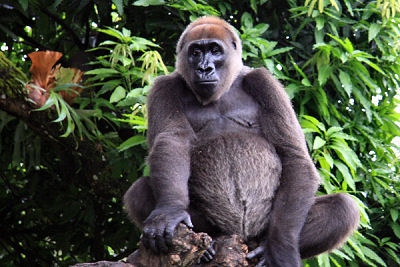- Cross River Gorilla
Taxobox
name = Cross River Gorilla
status = CR
status_system = iucn3.1
trend = down
status_ref = IUCN2007 | assessors = Oates, J.F., Bergl, R.A., Sunderland-Groves, J. & Dunn, A. | year = 2007 | title = Gorilla gorilla" ssp. "diehli | id = 39998 | downloaded =2007-09-13 ]

regnum =Animal ia
phylum =Chordata
classis =Mammal ia
ordo =Primate s
familia =Hominidae
genus = "Gorilla "
species = "G. gorilla"
subspecies = "G. g. diehli"
trinomial = "Gorilla gorilla diehli"
trinomial_authority = (Matschie, 1904)The Cross River Gorilla ("Gorilla gorilla diehli") is a subspecies of the
Western Gorilla ("Gorilla gorilla") that can be found on the border betweenNigeria andCameroon , in bothtropical and subtropical moist broadleaf forests . While allWestern Gorilla s areCritically Endangered (in the case of theWestern Lowland Gorilla ("Gorilla gorilla gorilla") due in part toEbola virus ), the Cross River Gorilla is the most endangered of the african apes, and is one of the world's 25 most endangered primates according to theIUCN Primate Specialist Group. [ [http://www.primate-sg.org/T25full07.htm IUCN Primate Specialist Group] ]The Cross River Gorilla differs from the Western Lowland Gorilla in both
skull andtooth dimensions. Based on these differences, the Cross River gorilla was described as a distinct subspecies in 2000, though previous analyses had also recognized the distinctiveness of these gorillas. [Sarmiento, E. E. and Oates, J. F. 2000. Cross River gorillas: A distinct subspecies, Gorilla gorilla diehli Matschie, 1904. "American Museum Novitates" 3304: 1-55.]Estimates on the number of Cross River Gorillas remaining vary, with around 250 to 300 believed to remain in the wild, concentrated in approximately 11 locations. Recent genetic research [Bergl, R. A. and Vigilant, L. 2007. Genetic analysis reveals population structure and recent migration within the highlyfragmented range of the Cross River gorilla ("Gorilla gorilla""diehli"). "Molecular Ecology" 16: 501–516.] and field surveys suggest that these locations are linked by the occasional migration of individual gorillas. The nearest population of Western Lowland Gorilla is some 250 km away. Both loss of habitat and intense hunting for
bushmeat have contributed to the decline of this subspecies. A conservation plan for the Cross River gorilla was published in 2007 and outlines the most important actions necessary to preserve this subspecies. [ [http://www.primate-sg.org/PDF/CRG.Action.Plan.pdf Regional Action Plan for the Conservation of the Cross River Gorilla] ]Intelligent behaviour
A study published in
2007 in the "American Journal of Primatology " announced the discovery of the fighting back against possible threats from humans. [Wittiger, L. and Sunderland-Groves, J. 2007. Tool use during display behavior in wild cross river gorillas. "American Journal of Primatology" 69: 1307.] They "found several instances of gorillas throwing sticks and clumps of grass. [ [http://www.sciencedaily.com/releases/2007/12/071205122539.htm Science Daily] ] " This is unusual, because gorillas usually flee and rarely charge when encountered by humans.In
2005 , scientists from theWildlife Conservation Society observed the gorillas, and documented the first case of tool use among gorillas. Researchers discovered individual gorillas using sticks to check the depth of streams before crossing them. [ [http://www.sciencedaily.com/releases/2007/12/071205122539.htm Science Daily] ]References
External links
*ARKive - [http://www.arkive.org/species/GES/mammals/Gorilla_gorilla/ images and movies of the western gorilla "(Gorilla gorilla)"]
* [http://www.worldwildlife.org/gorillas/subspecies/cross_river.cfm Information on the Cross River Gorilla from the WWF]
* [http://www.sciencedaily.com/releases/2007/12/071205122539.htm Science Daily - World's Most Endangered Gorilla Fights Back]
* [http://blog.wired.com/defense/2007/11/gorillas-turn-t.html Damn Dirty Apes! Gorillas Use Weapons vs. Humans]
Wikimedia Foundation. 2010.
